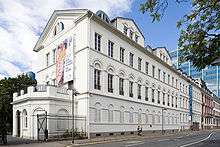Jewish Museum Frankfurt

The Jewish Museum Frankfurt am Main covers the history and culture of the Jewish communities in Frankfurt, Germany, from the 12th to the 20th centuries. There is another branch of the museum, the Museum Judengasse, in a different part of town.
History and description

The museum opened on 9 November 1988, the 50th anniversary of the pogrom Kristallnacht.[1] It includes the Börne Gallery, the Oskar and Emilie Schindler Learning Centre, the Ludwig Meidner Archive, the Commission for Historical Research into the Jews of Frankfurt, a library, and a media centre.
The museum is housed in two classical villas on the Untermainkai, across the Main from the Schaumainkai. The villa at no. 14 was built for the banker Simon Moritz von Bethmann, and the one at no. 15 for Joseph Isaak Speyer. No. 14 was acquired by Mayer Carl von Rothschild in 1846, and became known as the Rothschild Palace. Both buildings were acquired by the city of Frankfurt in 1928. After the Second World War they served as the main site of the municipal and university library, and later as an outpost of the Historical Museum.
The permanent exhibition displays works by Ludwig Meidner and Moritz Daniel Oppenheim, among others, as well as cultural artefacts from synagogues and Jewish homes. The Ludwig Meidner Archive includes the estate of the painter Henry Gowa.[2] Other artists in the museum's collection include Eduard Bendemann and Jacob Steinhardt.
Museum Judengasse

The Museum Judengasse, located at Börneplatz, was built on the foundations of several houses in the Judengasse (the Jewish ghetto, dating from 1462) that had been excavated in 1987. The museum documents the history of the Judengasse up to its abolition in 1796. Remnants from the walls of the Börneplatz synagogue are integrated into the museum.
To commemorate the 650th anniversary of the Golden Bull of 1356, four museums in Frankfurt organised an exhibition called Die Kaisermacher ("The Emperor-Makers") from 2006 to 2007. The Museum Judengasse contributed archaeological findings, documenting in particular the role played by the Jews of Frankfurt as the Emperor's servi camerae regis.[3]
See also
Footnotes
- ↑ Frank, Ben G. (2001). A Travel Guide to Jewish Europe. Pelican. p. 395. ISBN 978-1-56554-776-6. Preview at Google Books.
- ↑ Rektoren/Präsidenten Hochschule für Gestaltung Offenbach. (German)
- ↑ Stadtgeschichte: Auf den Spuren der Kaisermacher Frankfurter Allgemeine Zeitung, 28 September 2006. (German)
Further reading
- Hoppe, Jens (2001). Jüdische Geschichte und Kultur in Museen: zur nichtjüdischen Museologie des Jüdischen in Deutschland. Volume 393 of Internationale Hochschulschriften (in German). Waxmann. ISBN 3-8309-1178-5. Preview at Google Books
External links
| Wikimedia Commons has media related to Jewish Museum Frankfurt. |
- Home page in English, including
Coordinates: 50°06′26″N 8°40′28″E / 50.10722°N 8.67444°E